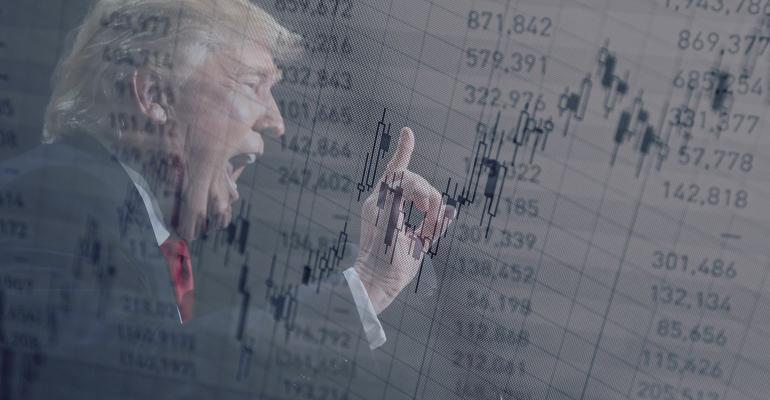By Matthew A. Winkler
(Bloomberg Opinion) -- Anyone perceiving the market turbulence of the past six months as a mere pothole on the road to the longest expansion in U.S. history should think again. The $6.7 trillion, 21 percent decline of the Russell 3000 from the high in September, and the $5.1 trillion rebound from the December low, are unprecedented and greater than the gross domestic product of Japan or the total U.S. trade with the world last year.
Even after the stock market recovered most of its losses, the 90-day average of daily price fluctuations hasn't diminished significantly since it climbed to a seven-year high in February. The pronounced anxiety among shareholders contrasts with a quiescent bond market where the U.S. Federal Reserve is comforting investors with the assurance that it is pausing from raising interest rates.
Extreme volatility represents a leap in the dark. The recent round of it was pernicious because it showed that investors no longer brush off President Donald Trump's disruptive global trade policies or mistake his daily tweets for meaningless noise.
The outsized market swings clash discordantly with a robust economy, demonstrating investor uncertainty about American business even in good times. Gross domestic product is growing at a healthy pace of 2.9 percent, inflation is at a reasonable 1.9 percent and unemployment hovers at 50-year lows, according to data compiled by Bloomberg.
Yet at least five of the 10 industries in the S&P 500 have recently been convulsed by the widest swings in value since 2012. DowDuPont Inc., a benchmark for materials, fell 15 percent during the past 12 months while in the consumer discretionary category, shares of Ford Motor Co. depreciated almost 17 percent. Ford Chief Executive Jim Hackett blamed Trump tariffs on a $1 billion profit drop even though the No. 2 U.S. automaker gets most of its metal from domestic sources.
During the past 12 months, the volatility of shares of Apple Inc., the icon of information technology, climbed to a decade high. News Corp., a pillar in communications, suffered a 21 percent depreciation during the same period amid record volatility for its shares. Caterpillar Inc., the economic bellwether, experienced the most extreme price fluctuations in seven years, losing 12 percent of its market capitalization during the past 12 months — 21 percent in a single month — amid rising metal and fuel costs related to the tariffs, according to data compiled by Bloomberg.
The surest indication that investors are souring on vast swaths of corporate America is reflected in the 3,000 U.S.-based exchange traded funds totaling $3.5 trillion. ETFs focused on industrial companies saw more than $5 billion of redemptions during the past 12 months with the largest such ETF, the Industrial Select Sector SPDR Fund, suffering a record $2 billion decline for the period. Consumer discretionary ETFs saw more than $2 billion of withdrawals, or 10 percent of their assets. The largest of them, the Consumer Discretionary Select Sector SPDR Fund, lost $500 million, the biggest 12-month rout since the fund's inception in 1998, Bloomberg data show.
“If you look at the indicators I have historically used in my business, they're not red yet, but they are definitely amber and they are setting off warning signs,” said the billionaire investor Stan Druckenmiller, chairman and chief investment officer of the Dusquesne Family Office in a December Bloomberg television interview. A month later, a survey of hundreds of corporate leaders showed a record jump in pessimism about the world economy amid increasing anxiety over trade disruptions.
Industries with the greatest price fluctuations and diminished confidence among investors are exporters to Asia, especially China. The 180 U.S. technology companies in the S&P 500 derive about 36 percent of their revenue from Asia, followed by materials, 24 percent; industrials, 18 percent; communications, 17 percent and consumer discretionary, 16.2 percent, according to data compiled by Bloomberg.
Some of these companies aren't waiting for a resolution to the trade wars. To avoid tariffs, GoPro Inc. CEO Nicholas Woodman told Bloomberg TV in February that most of its U.S.-bound camera production is moving from China to Guadalajara, Mexico, in the second quarter. Steven Madden CEO Edward Rosenfeld last month told investors that his company also is shifting production, primarily to Cambodia. As recently as 2018, only 16 percent was based outside China. Today, the ratio is approaching 50 percent.
If there is any certainty in the Trump trade imbroglio, few U.S. companies are bringing their production back home. Badrinarayanan Kothandaraman, CEO of Enphase Energy Inc., which manufactures power solutions, told investors during a November earnings call: “We recognized the need to have contract manufacturing outside China. We are already proceeding towards qualifying Mexico. I have already invested the capital for that. I'm going to have manufacturing in Mexico in six months to nine months.”
That would be another ominous development for Trump's America First campaign. For the first time since the 2008 financial crisis and the worst recession since the Great Depression, Mexico is poised to overtake the U.S. in growth during the next three years, according to 32 economists surveyed by Bloomberg.
And that's another reason for investors to be skittish about the Trump trade.
(With assistance from Shin Pei)
Matthew A. Winkler is a Bloomberg Opinion columnist. He is the editor-in-chief emeritus of Bloomberg News.
To contact the author of this story: Matthew A. Winkler at mwinkler@bloomberg.net
For more columns from Bloomberg View, visit bloomberg/view





